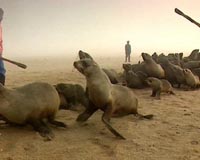| . |  |
. |
Corvallis OR (SPX) Jul 27, 2009 From the time he was 21 and working toward his Ph.D., Mike Behrenfeld has been observing phytoplankton - floating ocean plants that have a global impact. Observing these tiny plants under a microscope, Behrenfeld discovered early on that how you set up an experiment matters. Researchers had previously observed that "fat and happy" plankton in a sterile laboratory dish suffer considerably when exposed to ultraviolet radiation. But perform the same experiment while simulating the abundance of real-world stresses that phytoplankton face every day in the ocean, and the impact of ultraviolet radiation is much smaller, Behrenfeld found. Now a phytoplankton ecologist and physiologist at Oregon State University, Behrenfeld studies phytoplankton in the lab but also makes a point of regularly going out to sea to stay grounded in the "real world." He also employs a big-picture tool: the view from space. Behrenfeld's introduction to satellite data came during his tenure at Brookhaven National Laboratory, where he learned how space-based instruments can measure ocean color and detect phytoplankton's green pigment. "That's when I began thinking in earnest about the global aspects of phytoplankton ecology," Behrenfeld said. "I was able to combine physiological knowledge of processes at the cellular level that I learned from the lab with the big picture of looking at global systems from space." Now, with more than ten years of ocean color data from NASA's Sea-viewing Wide Field-of-view Sensor (SeaWiFS) instrument, Behrenfeld has developed a new theory about the timing and cause of the North Atlantic Bloom. This annual bloom of phytoplankton spans the entire ocean at northern latitudes, and is responsible for feeding marine birds and mammals, as well as soaking up carbon dioxide from the atmosphere. Behrenfeld found that the classic understanding of the bloom - that warm spring temperatures and abundant sunlight drive its onset - may be mistaken. Instead, satellite data show that the bloom begins in winter, when phytoplankton habitat extends deeper below the ocean surface. Phytoplankton are diluted over a larger habitat volume, decreasing their chance of encountering a predator, allowing the population to grow, and initiating a bloom. Only later, in spring, do favorable growth conditions at the surface contribute to the bloom. "With space-based tools, we can go back and look at these old paradigms in a new way," Behrenfeld said. "The satellite measurements were the absolute central piece of the work, but their interpretation required background knowledge from the laboratory and field techniques." Behrenfeld encourages the next generation of young scientists - whether they are focused on satellite data, computer models, laboratory experiments or optics - to take a diversified approach to scientific inquiry and to get out into the real world as much as possible. "Getting away from the computer and simply thinking about things for awhile opens up new questions you want to ask," he said, "and feeds our scientific curiosity about how organisms and natural ecosystems work." Share This Article With Planet Earth
Related Links Oregon State University Darwin Today At TerraDaily.com
 Namibia seal slaughter goes ahead after failed deal
Namibia seal slaughter goes ahead after failed dealIstanbul (AFP) July 24, 2009 An Australian-based fur company has begun culling baby seals in Namibia after animal rights activists failed to pay on time the millions of dollars they pledged to buy the company out, the owner said Friday. "Nothing came from these associations and we have begun the annual slaughter," Hatem Yavuz -- who has offices both in Sydney and Istanbul in his native Turkey -- told AFP. Earlier ... read more |
|
| The content herein, unless otherwise known to be public domain, are Copyright 1995-2009 - SpaceDaily. AFP and UPI Wire Stories are copyright Agence France-Presse and United Press International. ESA Portal Reports are copyright European Space Agency. All NASA sourced material is public domain. Additional copyrights may apply in whole or part to other bona fide parties. Advertising does not imply endorsement,agreement or approval of any opinions, statements or information provided by SpaceDaily on any Web page published or hosted by SpaceDaily. Privacy Statement |